Despite the efforts from a lot of people, Major Richard D. Winters never received the Medal of Honor.
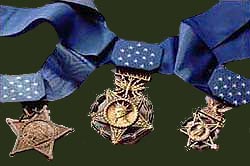
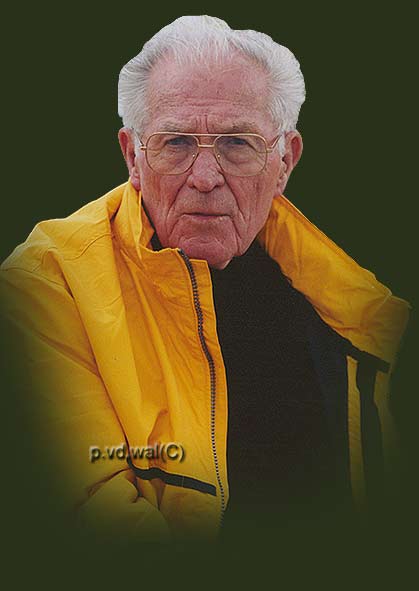
Richard D. Winters was at the time of the action on June 6, 1944 (D-Day) first Lieutenant from E Company, 2nd Battalion, 506th Parachute Infantry Regiment, 101st Airborne Division
His men from E-Company always wanted their commander being honored for his extra ordinary leadership during the action in Normandy were he knocked out 4 German 105 mm guns.
A lot of people wrote to the governor and... among them C.Carwood Lipton who's letter you can read below.
The
following account describing the capture and destruction of Four German
105mm guns on the morning of D-Day in Normandy covers my memories if the
events of that action.
C. Carwood Lipton
104 Selkirk Trail
Southern Pines NC
28387
D-DAY
The German 105’s
By about 8AM on the morning of D-Day, June 6, 1944, there were thirteen
of us together from B Company of the 506th Parachute Infantry Regiment.
We had joined together by two’s and three’s following our jump
into Normandy shortly after 1:30 that morningning. The rest of our
company was scattered over the Normandy peninsula, and it would take several
days for those who had survived the jump and the combat following it to
join us.
We had two officers, Lt. Winters in command and Lt. Compton; two platoon
sergeants, Guarnere and I; and nine men, and we had two machine guns, a
60mm mortar, and our individual weapons. We had moved along the road network,
led by Lt. Winters, from the vicinity of Ste. Mere Eglise, where many of
us had landed, to a small village named Le Gran Chemin, near Ste. Marie
du Mont, joining up along the way with men from other companies in our Battalion
and with some of our Battalion headquarters.
The entire group was stopped there by the sound of German artillery firing
from a wooded hedgerow area off to the right of the road that we were on.
Lt. Winters was called to Battalion and was ordered to take and destroy
those guns with his company. None of us had been in combat before that day.
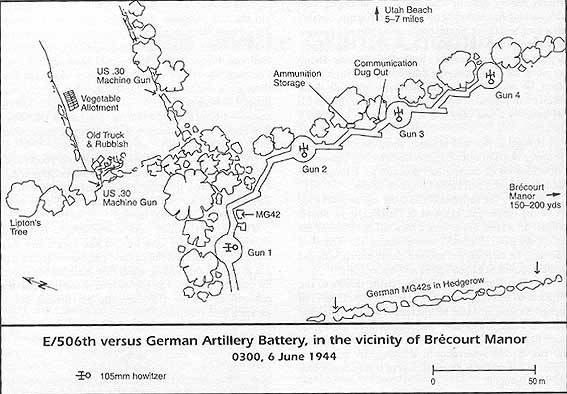
His plan was to concentrate a double envelopment attack onone gun, the one on the German left flank, and after capturing it to hit the other guns, one by one, on their open left flanks.He sent Ltn. Compton and Guarnere around to our left to hit the Germans on the first gun from their right front. He sent Sgt.Ranney and me around to our right to put fire into the German positions from their left flank He set up the two machine guns in position to put heavy continuous fire into the German positions from their front. He then organized and led the rest of our men in a direct assault along the hedgerow right into the German positions.
With fire into their positions from both flanks, heavy machine gun fire into their front, and Ltn. Winters leading an assault right into their
defenses the Germans apparently felt that they were being
hit by a large force Those defending the first gun broke and withdrew in disorganization
to a far tree line, and that gun was in our hands.
Our attack then continued to each gun in turn from its exposed left flank.
Lt winters blew out the breeches of each gun as soon as we had it with blocks
of TNT. In all, the Germans lost 15 men killed three of them by Ltn. Winters
- 12 captured, and many wounded. In E Company we had one man killed and one
wounded.
These guns were sited to put artillery fire on the full expanse of Utah Beach,
where the us 4th Division was coming ashore from landing craft. They had forward
observers along the beach to direct the fire. The capture and destruction
of the guns was a major factor in the success of the Utah landings and in
the almost complete lack of casualties in that Division during its landing.
I was in many combat operations throughout the war in Europe, and, to rue,
this was the most outstanding example of a combat leader reading a situation,
forming a plan to overcome almost impossible odds, organizing and inspiring
his men so that each one would confidently handle his part of the plan, and
leading his men in the most dangerous parts of the operation
C. Carwood Lipton/J October 30, 2000
North Carolina
Moore County
A Notary Public for said County and State, do hereby certify that personally
appeared before me this day and acknowledged the due execution of the foregoing
instrument.
Witness my hand arid office seal, this the 30th day of October 2000.
My commission expires May 1 2005
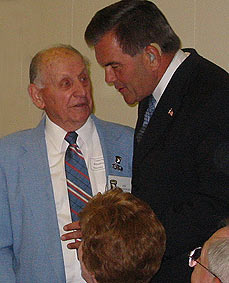
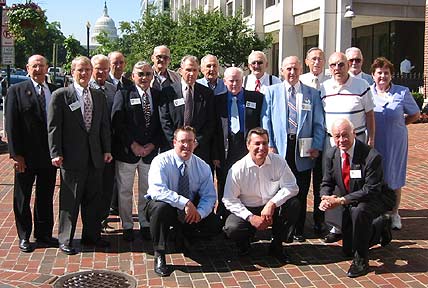
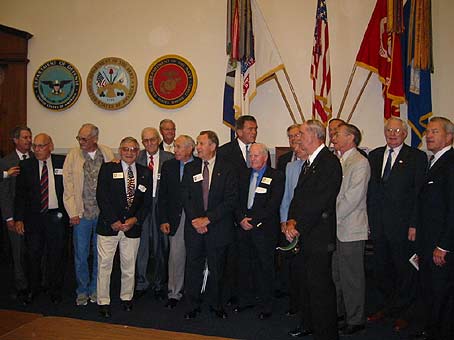
July 2003, the following Easy Company veterans went to Washington
Capitol Hill to talk to Secretary Tom
Ridge, Homeland Defense "The men of Easy Company never forgot Winters' action
as he led them across the field of battle that first day of the war in France.
For his actions he received the Distinguished Service Cross, though his Regimental
commander had put him in for the Medal of Honor. The men of Easy Company have
spearheaded an effort to get Winters the Medal of Honor. They have spoken
publicly, visited congressmen and senators, and addresses the pentagon on
the matter. They feel Winters' leadership deserves the proper recognition."text
from D-Day 60th anniversary special issue
Ed Joint-Shifty Powers-Forrest Guth-Earl McLung-Buck Taylor-Clancy Lyall-Joe
Lesniewski-Jack Foley -Ed Tipper.
Detail of Actions 6/9/44
Second Battalion while marching through above mentioned town 0930 D-Day was fired on point blank by a battery of four 105's, from a range of 350 yards ... same battery was also firing on troops on the beach. Nine men and two Officers made the assault.
The enemy had dug positions in a hedgerow around the perimeter of a rectangular field - about 1200 yards total in length. One corner of this position had a hedgerow that led into the entrenchment. Covering this hedgerow and the enemies flank were one 105, a M.G. and few riflemen. The other three 105's were firing out toward the beach and on the battalion they had pinned down.
The assault team decided on attacking the position down the one hedgerow that led to this entrenchment - all other approaches were across open fields. So under fire from the 105 protecting this flank and also small arm fire, the party worked their way into position and then opened up with all the fire power they could muster to pin the enemy down, while SGT Guarnere lead a group of three men to a position where he could hand grenade them.
The combined small arms fire and grenades drove the enemy out of the entrenchment protecting the flank, permitting the assault team to gain a fast hold. More grenades drove then gun crew of three from the first 105, who were killed before they had gone twenty-five yards. SGT Guarnere accounted for one of the three. The assault team was reorganized here again, and as in each case to follow, SGT Guarnere displayed extraordinary gallantry and disregard for his own safety in see that this job was done correctly. By his very attitude and manner and display of confidence, he inspired the whole assault team and displayed the type of leadership that wins battles. After reorganizing the team, knocked out a M.G. and crew by rifle fire that was firing at us through the entrenchment. Immediately the team rushed the second 88 and crew, leaving behind three men to protect the rear. In the second assault, SGT Guarnere was again lead man and by using the same tactics, the second position was taken and five Germans killed, with no losses to ourselves.
At this time six Jerries decided they had enough and advanced with hands over head calling to us "No make me dead". They were immediately returned to the battalion along with all the documents and maps we could find - one map was of great value for it showed all 105 emplacements and entrenchment's of the defensive set-up of the peninsula.
With all four guns taken and destroyed, we withdrew out of the position, and continued to harass the enemy with M.G. and 60 MM mortar fire - which had just arrived - until two tanks arrived. Then we made an assault with the tanks and cleaned out the position. In all we suffered six wounded and four killed, the enemy had 15 killed - SGT Guarnere personally accounted for five - and captured twelve. Enemy forces estimated at about forty-five.
Mission completed, we rejoin our battalion, which had departed after the four 105's were destroyed, for their objective.
Supporting Data:
Battery of four 105's was destroyed which permitted troops on the beach to land without casualty, and battalion to move on to complete it's original mission.
Somebody else wrote the following proposed citation
The President of the United States of America,
authorized by Act of Congress, March 3 1863, has awarded in the name of The
Congress the MEDAL OF HONOR to
FIRST LIEUTENANT RICHARD D. WINTERS
UNITED STATES ARMY
for conspicuous gallantry and intrepidity in action at the risk of his life
above and beyond the call of duty:
Proposed Citation: First Lieutenant Richard D. Winters Company E. 2nd Battalion,
506th Parachute Infantry Regiment, 101st Airborne Division, distinguished
himself by conspicuous gallantry and intrepidity above and beyond the call
of duty in action on 6 June 1944 in the vicinity of Le Gran Chemin, Normandy,
France. During the early phases of the airborne assault on D-Day, Lieutenant
Winters assumed temporary command of Easy Company, then numbering twelve men,
and advanced to destroy a German four-gun battery of 105mm artillery pieces
that was placing indirect fire on UTAH Beach. Lieutenant Winters personally
conducted a reconnaissance under direct enemy fire and quickly stabled that
quick, violent action was required to destroy the battery and it's 50-man
enemy garrison. Organizing his men into support and assault teams, Winters
crawled toward the jump-off position. In the process, he noticed one German
Soldier and killed him instantly. With the support team engaging one enemy
gun. Winters placed himself in the lead of the assault column and charged
across the fire swept open field into the hedgerow where they silenced the
first gun. As the enemy crew retreated, Winters killed three more Germans
and planned to assault the second howitzer. Placing a machine gun to fire
down the trench, he gathered two soldiers and prepared to charge down the
trench in the direction of the second gun. Crawling forward in the trench
he noticed that his path was blocked by an enemy machine gun getting ready
to fire. Without hesitation Winters fired and wounded both members of the
enemy crew. Leaving three men to hold the first gun, Winters lead his remaining
five on a charge directly down the enemy trench throwing grenades ahead of
him. Urging his men forward by shouting encouragement and leading the assault
team, Winters captured the second gun and discovered a map that depicted all
the German artillery and machine gun positions throughout the Cotentin Peninsula.
Sending the map back to headquarters, Winters then directed the assault on
the third gun which he quickly captured. With three guns under his direct
control, Winters halted only long enough to destroy the barrels of the enemy
guns. Still under direct fire, Winters then ordered another platoon to capture
the final gun, which they did in short order. With his mission accomplished
and now under intense fire from machine guns from the hedgerows adjacent to
neighboring Brecourt Manor, Winters finally ordered a withdrawal. As was his
custom, Winters was last out, but not before killing another German rifleman.
With what amounted to a squad. Winters and his men had killed 15 German soldiers,
wounded many more, and taken 12 prisoners. In all, Winters killed at least
five Germans and his whirlwind hand-to-hand assault had resulted in the destruction
of the complete battery and the entire fifty-man platoon of the elite German
paratroopers defending the battery. Later that afternoon Winters harassed
the enemy forces, preventing their return to the fortified position until
armored forces from the amphibious forces secured Brecourt Manor. The superb
leadership, conspicuous courage, and consummate devotion to duty demonstrated
by Lieutenant Winters were directly responsible for the successful accomplishment
of a hazardous mission and served as an inspiration to his men and exemplify
the heroic traditions of the military service.
PAGES:
PAGINA'S:
INDEX ENGLISH / INDEX NEDERLANDS
I do not intend to infringe on any copyrights.I just want to promote Band of Brothers© and pay a tribute to everyone who was involved in giving back our freedom in wwII
Any comments about the text or photos on this page please mail me